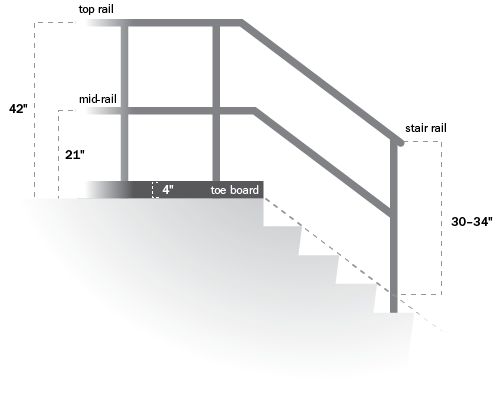
This diagram illustrates guidelines for railing and toe board height. All of the requirements for railing and toe board use and construction can be found under OSHA’s 1910.23 standard.
This article is from the Winter 2016 issue of The Quill. To view the full issue, visit The Quill archive.
Many OSHA violations are commonly overlooked throughout the transportation industry, primarily due to companies focusing on compliance with DOT regulations. A few violations that are very common in maintenance and storage areas are associated with overhead storage, sometimes referred to as “mezzanines.” As companies grow, their storage needs typically grow as well, resulting in the use of available and convenient overhead storage. Following a few easy steps can help you comply with OSHA standards and make these areas safer for your employees. The standards associated with overhead storage areas can be found under 1910 Subpart D Walking-Working Surfaces.
Overhead Load Ratings
The most common OSHA violation for overhead storage is not having a posted load rating. This violation is easily overlooked because the hazard is not as commonly recognized as railing violations. 1910.22(d)(1) requires the building owner, or someone acting under the owner’s approval, to conspicuously post an approved sign that identifies the floor load rating of any area used for “mercantile, business, industrial, or storage purposes.”
If you are not the building owner, the first step should be to speak with that individual to determine if any structural analysis and load ratings have been documented. If you already have documented load ratings, the ratings must simply be posted conspicuously on OSHA compliant signs in the areas the ratings cover. If you or the building owner do not have documented load ratings, speak with a structural engineer to have them perform an analysis of your building and determine the appropriate load ratings. Following this standard is not just important for avoiding fines, but could prevent a serious overloading incident that could easily result in an employee fatality or lead to very costly repairs to your building.
Railing and Toe Boards
Other common OSHA violations involving overhead storage areas or walkways are caused by missing, insufficient or incomplete railing and toe boards. Generally, railing for overhead storage areas is constructed at the location using 2x4 boards or pre-made metal railings that are screwed or bolted to the floor. Railing is also often constructed from threaded metal pipe and pipe fittings. The top rail must be 42 inches from the floor and the mid-rail should be approximately 21 inches from the floor on center. The railing must support at least 200 pounds of force from the top rail in any direction.
A toe board at least 4 inches high must be in place and can be attached ¼ inch or less from the floor. A common toe board violation results from using a 2x4 board. These boards are typically 3 ½ inches high and will not meet the height requirement even when a ¼ inch gap between the toe board and floor is present. If materials are piled above the height of the toe board, paneling up to the mid-rail or top rail should be used to prevent the material from falling.
Open Spaces and Railings
Fixed ladders, floor hatches and any open spaces used to access the storage area with a forklift must also be railed or offset so that an employee cannot walk off the edge. A gate or removable railing with a top- and mid-rail must be used at any opening in the railing for a ladder, stairway or forklift/chain hoist access. A fixed railing with toe boards must be around all exposed sides of a ladder, stairway or floor hatch except at the entrance to the platform. Removable toe boards should be used for larger openings that may be used for forklift or chain hoist access if there is a risk of objects or materials falling from the storage area.
Stairways and Railings
Stairways that are less than 44 inches wide must have railing on each open side and a handrail on at least one enclosed side if one or more sides are enclosed. If both sides of the stairway are enclosed and only one handrail is used, the handrail should be on the right side of a person descending the stairs if possible. Stairways that are over 44 inches wide must have all of the above, but require a handrail on both sides if both sides are enclosed. Stairways that are at least 88 inches wide must have railing running down the approximate middle of the stairway. Handrails and railing should be between 30 and 34 inches above the front edge of the tread in line with the face of the riser.
The above requirements are general rules found in 1910 Subpart D, Walking-Working Surfaces, and do not represent the entirety of the standard. All of the requirements for railing and toe board use and construction can be found under OSHA’s 1910.23 standard.